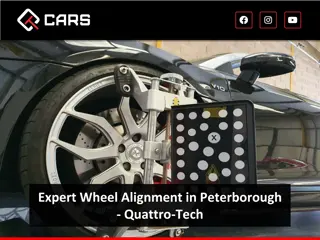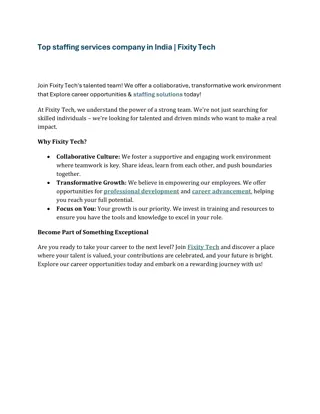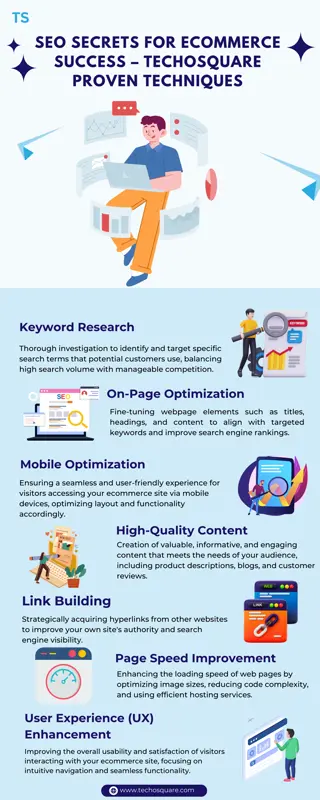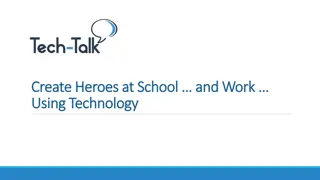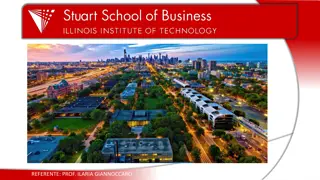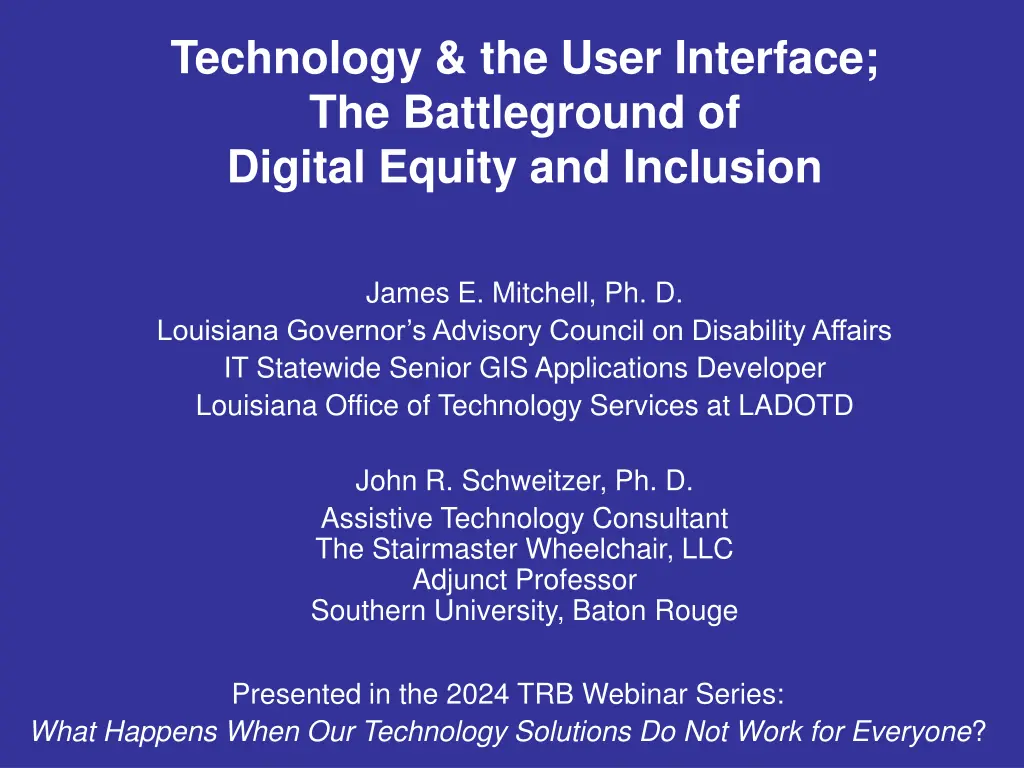
Understanding the Impact of Inaccessible Technology on Digital Equity
Explore the challenges created by inaccessible technology in the realm of digital equity and inclusion. Learn how an inaccessible user interface can perpetuate social inequities and hinder access to vital resources and opportunities in society.
Download Presentation

Please find below an Image/Link to download the presentation.
The content on the website is provided AS IS for your information and personal use only. It may not be sold, licensed, or shared on other websites without obtaining consent from the author. If you encounter any issues during the download, it is possible that the publisher has removed the file from their server.
You are allowed to download the files provided on this website for personal or commercial use, subject to the condition that they are used lawfully. All files are the property of their respective owners.
The content on the website is provided AS IS for your information and personal use only. It may not be sold, licensed, or shared on other websites without obtaining consent from the author.
E N D
Presentation Transcript
Technology & the User Interface; The Battleground of Digital Equity and Inclusion James E. Mitchell, Ph. D. Louisiana Governor s Advisory Council on Disability Affairs IT Statewide Senior GIS Applications Developer Louisiana Office of Technology Services at LADOTD John R. Schweitzer, Ph. D. Assistive Technology Consultant The Stairmaster Wheelchair, LLC Adjunct Professor Southern University, Baton Rouge Presented in the 2024 TRB Webinar Series: What Happens When Our Technology Solutions Do Not Work for Everyone?
Topics in this Presentation The Cycle of Digital Access and Social Inequity The interrelationship between Information Technology and Social Equity Functional Limitations and Digital Exclusion Equity and Inclusion Do Not Mean Opportunity and Engagement How Digital Equity and Transportation Combine in Our Mobile Society
The Cycle of Digital Access and Social Inequity Inaccessible Technology Fuels the Cycle Categorical Inequalities Create an Unequal Distribution of Resources Unequal Resources Creates Unequal Access The Information Technology Exists to Solve these Problems Unequal Participation Reinforces Categorical Differences and Inequalities Unequal Access Differs by Individual and Disability. Unequal Access Leads to Unequal Participation.
The Digital Divide Origin of the Cycle of Digital Access and Social Inequity This cycle is adapted from the work of Jan A. G. M. Van Dijk, University of Twente, Netherlands, who coined the term, Digital Divide. The Digital Divide defines a boundary, that splits people into haves, or have-nots, with respect to access to digital society. The cycle describes a progression of circumstances that categorize, marginalize, and perpetuates an individual s inability to participate in modern, digital society.
An Inaccessible User Interface (UI) Starts the Cycle A UI which is not designed to support assistive technology is an example of Inaccessible Technology. It blocks disabled persons from the information and resources behind it and creates Categorical Inequities. 1. Categorical Inequalities in society produce an Unequal Distribution of Resources. We have entered the cycle. If you lack transportation, you cannot take advantage of jobs, education, food and groceries, governmental and community activities Many of the resources (benefits) of modern society.
A Lack of Access to Societys Resources Leads to a Lack of Means to Attain the Technology to Participate Persons with disabilities are chronically under- or unemployed. The programs (education, rehabilitation, independent living, etc.); are traditionally underfunded. Assistive Technology is expensive. So, the disabled have, as a whole, less access to technology. 2. An unequal Distribution of Resources creates Unequal Access to technology. Disabled people are served by low-priority government and social programs with limited resources to provide training and technology.
All Inequities Are Not Created Equal There is No Single, Simple Solution Assistive Technologies are specialized and address specific Functional Limitations. The small number of manufacturers means there is little competition and market forces promote high prices. 3. Unequal Access to technology differs, based on the individual needs and characteristics of each technology and the disability they serve. Assistive Technology exists to aid the disabled. But, access to it is limited by the cost, as well as, availability of training to use it.
Everything is Moving to the Web What if YouCan t? Digital technology is becoming a larger part of daily life. Digital IDs, QR Codes, travel and event ticketing are all common-place. If you don t have access to the technology to use these, you are locked-out. 4. Unequal Access to technology leads to Unequal Participation in society. The lack of access to technology for disabled people limits their ability to participate in employment; civic, social, educational, library programs, and other mainstream social activities. Social invisibility promotes further isolation and marginalization, making it difficult to fully participate in a digital society.
Does Diversity, Equity, and Inclusion Mean Engagement and Opportunity? If you are not engaged, your interests and needs will not be represented. As diversity increases, the interests of small minorities are overlooked, then marginalized. This isolation traps you in the cycle. 5. Unequal Participation in society reinforces Categorical Inequalities and the Unequal Distributions of Resources. With Assistive Technology, people with disabilities can break the cycle. Properly designed, Technology and the User interface can provide the opportunity for disabled persons to engage in society.
The Cycle of Digital Access and Social Inequity Inaccessible Technology Fuels the Cycle Categorical Inequalities Create an Unequal Distribution of Resources Unequal Resources Creates Unequal Access The Information Technology Exists to Solve these Problems Unequal Participation Reinforces Categorical Differences and Inequalities Unequal Access Differs by Individual and Disability. Unequal Access Leads to Unequal Participation.
The International Classification of Functioning, Disability, & Health Sensory Impairments Physical Impairments Cognitive Impairments Technology must address these limitations by adopting the principles of Universal Design. Source: The World Health Organization (WHO)
Technology Needs to Facilitate Functional Capacities Communication Interpersonal Skills Mobility Motor Skills Self Care Self-Direction Work Skills Work Tolerance From the Rehabilitation Act of 1973 (PL 93-112), as Amended
What is Assistive Technology AT means, technology designed to be utilized in an assistive technology device or assistive technology service. Source: Assistive Technology Act of 2004 (P.L. 108-364)
Assistive Technology Commonly Used by People with Disabilities Wheelchairs Orthotics/Prosthetics Vehicle Modifications Low or No Vision Aids Alternative/Augmentative Communication (AAC) Other Assistive Technology Devices Rehabilitation Engineering Society of North America https://resna.org
What is Digital Equity? How Does Transportation Affect the Cycle? The condition in which all individuals and communities have the information technology capacity needed for full participation in our society, democracy, and economy. From the National Digital Inclusion Alliance (2022) https://www.digitalinclusion.org/definitions Imagine a World Without Access to Highways or Transportation. Today, participation in society involves an interplay between physical mobility and information access. Much of the use of traditional roads and high ways has been replaced with access through the Information Super Highway. Many goods and services that were only available if you left your home are only now accessible through the Internet.
How Have Transportation and Digital Technology Combined in Our Society As Transportation evolved, society and people have become more mobile. The disabled have not been able participate in this. For decades, public transportation was not accessible to people using wheelchairs. Accessible vehicles have only been available for the past 40 years. As technology has evolved, assistive technology has followed, providing access by overcoming the functional limitations of disabled persons. IN TODAY S MOBILE SOCIETY, TRANSPORTATION AND TECHNOLOGY ACCESS ARE ESSENTIAL
Why Does Transportation Technology Need to Promote Independence Children converting their interests, through education, into a career goal of their choice. People participating fully in society in a manner of their own choosing. People engaged in their children s schools, local libraries, and other community activities. People who are engaged in life, participating in society, and making a contribution to them.
Transportation & IT Play Integral Roles to Enable Disabled People to Escape the Cycle There are Four Opportunities for IT to Help Disabled People Cross the Digital Divide: Direct Effects: Provide Resources (Hardware, Software, Training) to Increase Societal Access Increase Participation Through Accessible Technology Decrease Categorical Inequities through Increased Access Indirect Effects: Access to Disability Resources (Agencies, Programs, and Community Resources)
Fundamental Concepts of Digital Equity Related to Persons with Disabilities People with disabilities: Need the same access to connectivity, economic, social, and transportation services afforded the general public Have the same need to access goods and services in an increasingly digital society However, people with disabilities must bridge the Technology Gap. This requires Assistive Technology (AT) to use broadband services.
All IT & Transportation Projects Should Incorporate Universal Design Principles Architect Ron Mace proposed the 7 Universal Design (UD) Principles in the 1980s. Applying Universal Design principles will minimize the digital exclusion of those with functional limitations.
The Seven Principles of Universal Design 1. Equitable Use 2. Flexibility in Use 3. Simple & Intuitive 4. Perceptible Information 5. Tolerance for Error 6. Low Physical Effort 7. Size & Space for Access Reference S. Burgstahler, www.uw.edu/doit
Contact Information James E. Mitchell, Ph. D. Governor s Advisory Council on Disability Affairs Louisiana Office of Technology Services IT Statewide Senior GIS Applications Developer jim.mitchell@la.gov John R. Schweitzer, Ph. D. Assistive Technology Consultant The Stairmaster Wheelchair, LLC Adjunct Professor Southern University, Baton Rouge johnrschweitzer@gmail.com




